Kielland disaster: Families seeking answers 44 years on
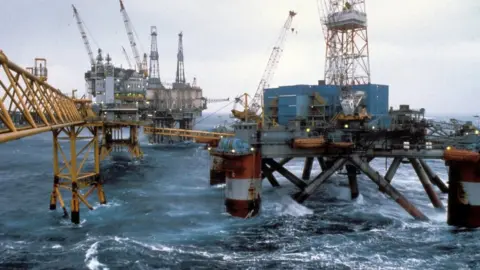 Unknown/Norwegian Petroleum Museum
Unknown/Norwegian Petroleum MuseumOn a stormy night in March 1980, 22 British men were among more than 120 killed when a floating accommodation platform capsized in the North Sea oil fields. It was Norway's biggest ever industrial disaster but families of those who died say they are still seeking justice. The BBC joined some of them in their hunt for answers.
On a barren clifftop near Norway's self-professed oil capital Stavanger, an enormous metal chain erupts from the rock.
Beneath it, cast on three weather-beaten copper panels, are the names of 123 men who lost their lives 200 miles (320km) out beyond the horizon.
Laura Fleming brushes aside the red hair she inherited from her father Michael as she lays a single rose at the base of the Brutt Lenke (broken link in Norwegian) memorial.
Mr Fleming, a 37-year-old engineer, was one of five men from Cleator Moor in Cumbria who perished when the Alexander L Kielland platform capsized on 27 March 1980.
 BBC
BBC"I never say my dad died," Ms Fleming, who was six at the time and now lives in Durham, said.
"He was killed. Disasters happen, but this one shouldn't have done, it was entirely preventable."
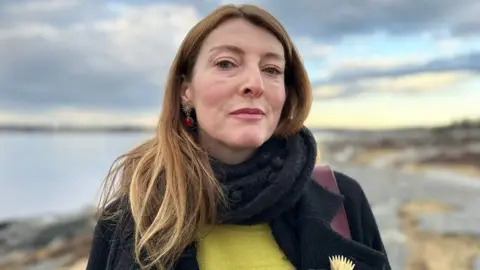 BBC
BBCStanding beside her, Wayne Hunter nods in agreement.
Having been just four years old in March 1980, he never really knew his father Keith, also from Cleator Moor.
Mr Hunter was one of six men whose bodies were never found.
 BBC
BBC"It's like a grave for us," his son says about the broken chain. "It's the only thing we've got.
"Being here, I do feel close to him."
Mr Hunter and Ms Fleming both grew up knowing their dads died at sea, but it was only two years ago they found out the extent of what happened. They were contacted and brought into the Kielland Network, a campaign group set up by grieving families in Norway.
The more information they got, the more answers they wanted
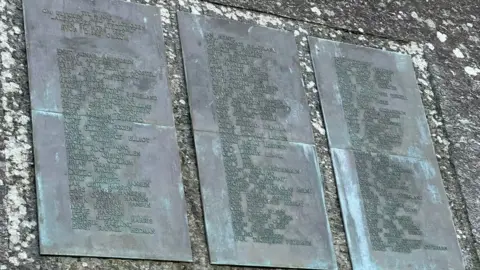 BBC
BBCOn the evening of 27 March 1980, their fathers were among 212 men aboard the Kielland, a French-built, semi-submersible platform named after a famous Norwegian writer, which served as a "flotel" for workers of the nearby Edda drilling rig.
At about 18:30, with 46mph winds and 40ft-high waves battering the Kielland, one of its five enormous legs snapped off.
The rig listed instantly to 30 degrees, sending men, debris and the four-storey accommodation block on its deck sprawling.
Six anchor cables, unable to cope with the sudden extra strain, shattered, claiming a number of lives, while several of the seven 50-seater lifeboats were either unable to be freed from their suspension hooks or were dashed against the rig, killing those who had sought sanctuary inside.
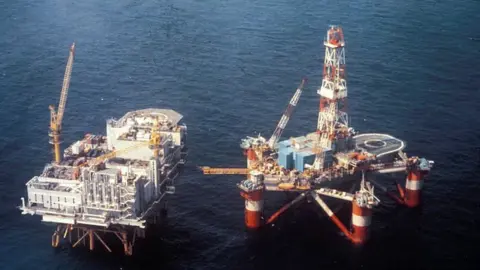 Unknown/ConocoPhillips/Norwegian Petroleum Museum
Unknown/ConocoPhillips/Norwegian Petroleum MuseumSeawater surged in through doors which were supposed to be shut. They had been propped open to allow cables and pipes to run through, as part of the rapid work going on board to convert the Kielland back into a drilling rig.
Drill bits, tools and equipment flew across the decks, some smashing into men who, just moments before, had sat down to enjoy a western movie in the Kielland's makeshift cinema, fashioned from sheet walls.
After 20 minutes or so, the final two cables holding the Kielland snapped, and the four-year-old, 10,000-tonne platform flipped over.
Workers on the nearby Edda used rescue baskets attached to cranes to try and pluck their friends and colleagues from the waves, while ships and helicopters tried to snatch people to safety.
Among the 89 survivors was Glaswegian John Aird, a friend and colleague of both Mr Fleming and Mr Hunter.
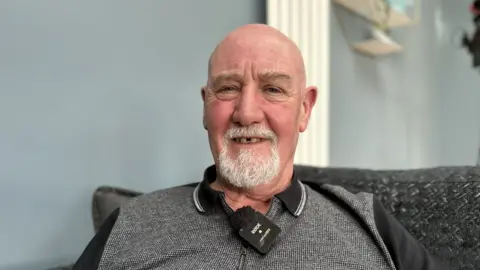 BBC
BBCThe day before the disaster, Mr Aird had been one of 12 men to make the regular commute from Teesside Airport near Middlesbrough to Norway, off to start the next of his two-week-long, 12-hour-a-day shifts.
He was the only one to return.
Mr Aird still vividly recalls what happened on that night 44 years ago.
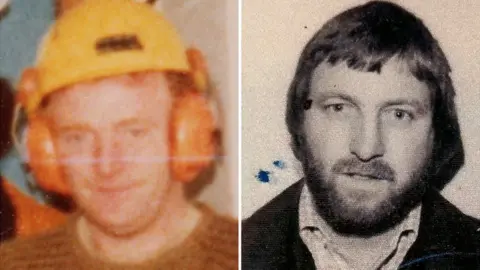 Unknown/Norwegian Petroleum Museum/Hunter family
Unknown/Norwegian Petroleum Museum/Hunter familyThe then-32-year-old had just finished his dinner in the canteen and taken his seat in the cinema when he heard an "almighty bang" and felt the world heave beneath his feet.
Self-preservation kicked in, and Mr Aird hauled himself up to the deck and into the nearest accommodation block to retrieve one of the lifejackets the men kept on top of their lockers.
He threw all the life preservers he could reach to other men, then pulled himself further up the sloping deck, away from the water now angrily smashing its way through windows and doors.
"I didn't feel any fear," he said. "You just wanted to get away from where the hassle was."
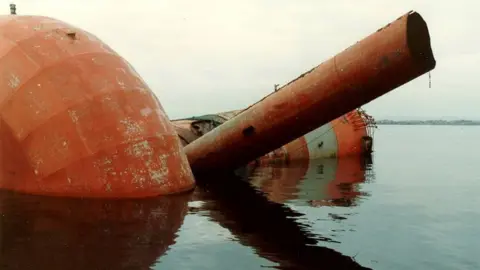 Unknown/Norwegian Petroleum Museum
Unknown/Norwegian Petroleum MuseumMr Aird got as high as he could and, with the storm still raging, looked around to assess his options.
It was then the final anchor cable severed and Mr Aird suddenly found himself plunged beneath the surface amid a confused mass of metalwork.
Miraculously, he bobbed up between the web of metal legs and braces to break back through into the open air.
"When I was going under, that's when it hit me and I thought I wasn't going to survive it," Mr Aird said. "It was just fate."
Among monstrous waves littered with other desperate men and detritus, he spotted a lifeboat emerge upside down a short swim away.
 BBC
BBCHe knew the boat would self-right itself, so kept himself away from its side as he swam closer.
Others were not so lucky, and were hauled over when the raft inevitably flipped over, the men disappearing beneath the surface, never to be seen again.
Two men already on board hauled Mr Aird inside, his trousers being torn off in the process. There then followed a torturous 11-hour ordeal, as the little boat was battered by waves with a dozen freezing and vomiting men on board, waiting for conditions to calm enough for a helicopter rescue.
Eventually Mr Aird was winched aboard a Sea King and flown to safety.
"Going up in the air was like being born again," he said. "Then I knew I was safe."
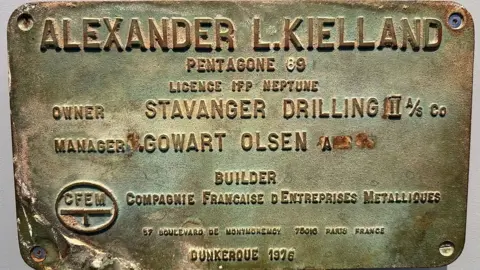 BBC
BBCHe went to two of his friends' funerals, including Ms Fleming's dad's, but returned to work on the oil rigs for fear of losing his career.
Tears come only once during Mr Aird's retelling of his story at his home in the Scottish village of Stoneyburn, as he says: "You hear about people being heroes and diving down and rescuing people, that was the last thing on my mind.
"I chastise myself for that sometimes, but it was just self-preservation."
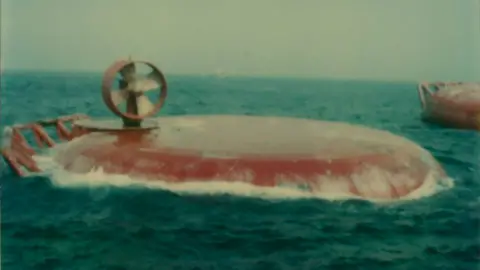 Unknown/Norwegian Petroleum Museum
Unknown/Norwegian Petroleum MuseumSo what actually went wrong with the Kielland? Why did it sink?
Subsequent investigations found a fatigue crack in the leg which sheared off.
The Norwegian authorities blamed the French manufacturers for an inadequate build, the French blamed the Norwegians and the Kielland's owners and operators, Stavanger Drilling and American firm Philips Petroleum, for not maintaining it properly or anchoring it suitably.
At the Norwegian Petroleum Museum near Stavanger harbour, Else Tungland drops 12 small wooden bricks onto a table.
Each represents an element that went wrong and contributed to making the disaster even more catastrophic, she says.
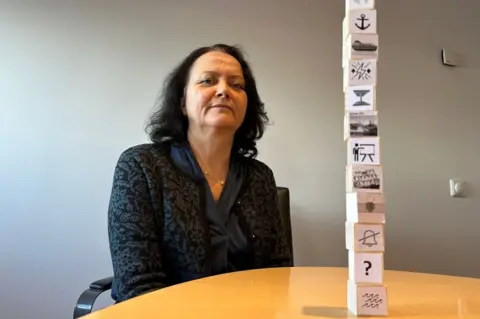 BBC
BBC"The lifeboat did not work, the workers were not trained, then they put a 'flotel' on top without knowing the calculation of stability," Ms Tungland says, starting to stack the bricks.
"Then who had responsibility for safety? The welding was not correct, the metal was not as good as it should have been, the alarm system was not working," Ms Tungland continues, the tower growing precariously.
Add in the weather, she says, the fact it was anchored with eight anchors instead of 10, doors supposed to be closed were open, an explosion and the lack of a support ship.
"All these things work together, it was not one thing that went wrong, but a chain," she says, as the tower collapses noisily, bricks scattering across the table.
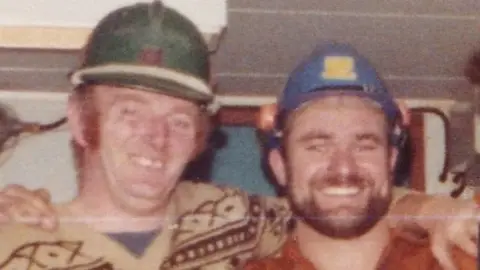 Brian Graham
Brian GrahamMs Tungland has spent 10 years researching the disaster and collecting the memories of survivors and relatives of the bereaved.
A big part of the remit of her project and the museum is to try and provide some answers for the families.
An inquiry was carried out by the Norwegian authorities within a year of the disaster, but it has been heavily criticised by the Kielland Network.
The group's leader Kian Reme, whose brother Rolf was among those killed, said much of the inquiry was held behind closed doors and a lot of the information it relied upon was not made public.
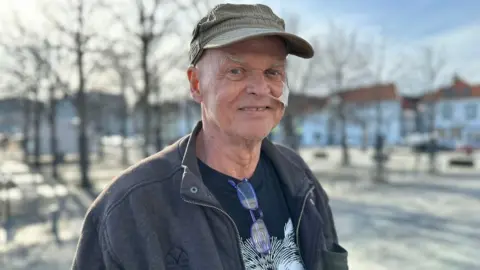 BBC
BBCThe families need closure that can only be provided by having all the information, such as the reports held in locked company archives, out in the open, Mr Reme says.
He wants the search for answers to conclude, but the honouring of the dead to never end.
"We have to deal with both things simultaneously," he says.
Mr Reme has published several books about the disaster, the latest of which features 89 questions he still wants answers to.
Gudny Hansen, who was 10 years old when her father Hans, the only Icelandic victim, was killed, said her sadness had been bolstered by anger and a drive for information.
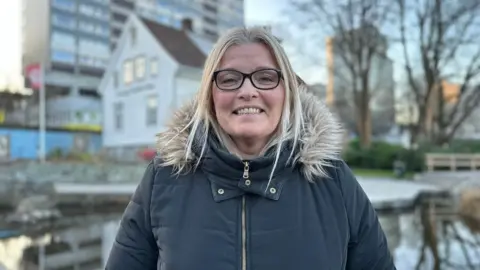 BBC
BBCShe and her two siblings said they never felt informed living in Iceland, so it was "destiny" when she moved to Stavanger in 2013 for a relationship.
"I thought this was an accident and my dad died," she says in her large living room, which overlooks fields and a golf course. The near constant hum of helicopters heading out to the rigs from the nearby Stavanger Airport can be heard in the background.
"It was a shock to be told actually your dad was killed," she says. "He didn't have to die and we are not getting answers."
Now Ms Hansen is a key part of the network pushing for information.
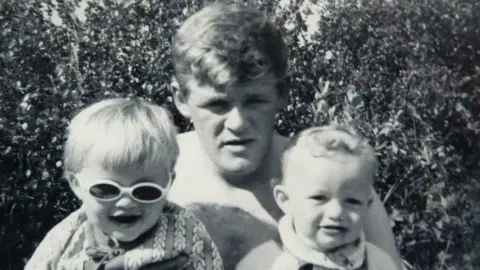 Gudny Hansen
Gudny Hansen"They say they know why the rig collapsed, but it wasn't supposed to be able to collapse, so there are a lot of questions," Ms Hansen says, her fingers playing with a shard of the Kielland fashioned into a necklace, which has been given to every survivor and bereaved relative.
For example, why was the work to convert it back to a drilling rig being done out on the open sea? Why was no action taken after the crack in the leg was spotted and reported? Why was an inspection allowed to be delayed?
"There are a lot of strange things," she says.
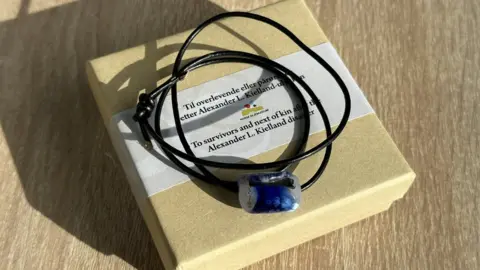 BBC
BBCIn 2021, the Norwegian auditor general reviewed the 1981 inquiry. While it found "highly reprehensible" failures to hold any of the companies involved in the disaster to account, or to support families and survivors, it ultimately concluded a new inquiry so long afterwards would yield nothing new.
In lieu of a new official investigation, the Norwegian government has funded the documentation project being managed by Ms Tungland in close cooperation with multiple groups including the Kielland Network, National Archives and University of Stavanger.
"The goal is to make sure relatives and survivors get answers to their questions," Ms Tungland says. "Every voice should be heard."
The lack of a new inquiry "doesn't mean we know all the answers," she says, but that it was "unlikely we will find more answers now because it's so long ago".
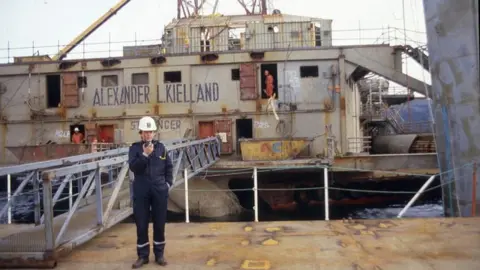 Sven Tønnessen/Norwegian Petroleum Museum
Sven Tønnessen/Norwegian Petroleum Museum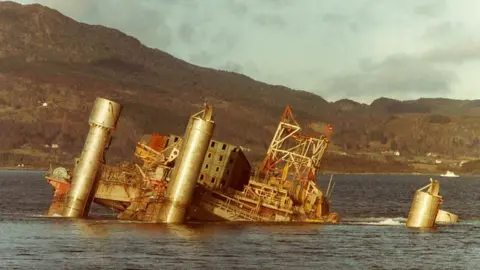 Unknown/Norwegian Petroleum Museum
Unknown/Norwegian Petroleum MuseumShe said many relatives wanted small but vital details, such as what colour socks their dad was wearing or what his final meal was.
Others want to know what caused the disaster, Ms Tungland says, how the system failed and who was to blame.
For the oil industry in Norway, a huge part of the nation's economy, the Kielland was seismic for safety, Bjorn Lindberg of the Petroleum Museum says.
"There is a major shift between before and after the accident," Mr Lindberg says, adding that a later review, following another accident, made 108 recommendations for the wider oil drilling industry - 104 of which were already in place in Norway because of the Kielland.
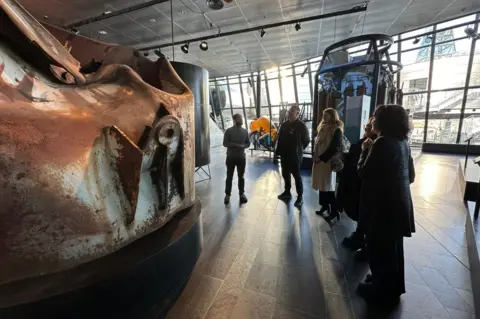 BBC
BBCMore information may be held in company archives but there may be a "good, rational explanation" for it not being released, Mr Lindberg says. "Secrecy is not always a sign of something suspect."
Ms Tungland agrees, saying: "The people that work in these places today don't know anything about the accident so don't even know what they have got in their archives."
With hopes of a new inquiry all but dashed, the Kielland Network has turned to mounting a legal challenge in an attempt to get compensation from the Norwegian authorities.
 BBC
BBCFor some it would go towards righting years of financial hardship caused by the death of their loved ones, but for others it would be symbolic of the state making some attempt to pay for the disaster which the families feel was so avoidable.
While the wreck of the Kielland lies deep in a Norwegian fjord, the questions and sense of injustice are still on the surface for survivors and the victims' families.
They all say they have forged a new family among the bereaved, and they exchange warm hugs and presents when they meet.
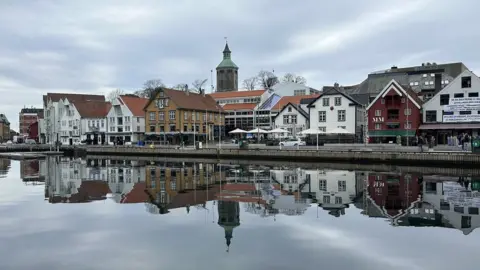 BBC
BBC"We are at the stage where I don't think we will ever get any sort of redress for the fact such serious mistakes were made," Ms Fleming says on her final morning in Norway.
She supports Mr Reme and the network's legal move for compensation, but adds: "It will always leave a bitter taste in my mouth that that's likely all we will ever get out of it."
 BBC
BBCThe Norwegian government declined to be interviewed, but issued a fact sheet about the disaster and its aftermath.
In it, a spokesman said the disaster had a "a devastating impact on those affected" with "substantial consequences for the bereaved and the survivors".
He said a compensation settlement was made in the 1980s, the accident was investigated in 1981 and a review by the general auditor in 2021 concluded there was "no basis" for a new inquiry. He said the authorities had been "thorough in their efforts to clarify the causes" but "certain weaknesses may have contributed to erode confidence in the investigation".
The review also found the "assignment and distribution of responsibility surrounding the accident were not adequately mapped", he said, and "no follow-up efforts were devoted to the bereaved" while "follow-up of the survivors was insufficient".
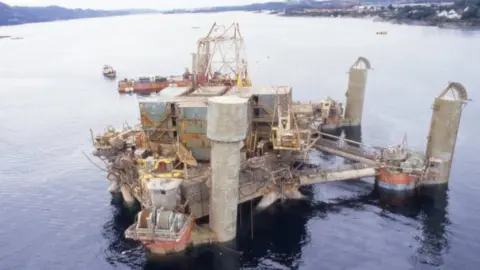 Sven Tønnessen/Norwegian Petroleum Museum
Sven Tønnessen/Norwegian Petroleum MuseumThe Storting, the Norwegian parliament, accepted the criticisms and "offered profound apologies" for the failures, allocating funding to a study of the impact of the disaster on the bereaved and survivors.
A spokesman for ConocoPhillips, the firm which now owns Phillips Petroleum, said the firm had "great sympathy" for those affected by the Kielland disaster.
He said: "Although we can't comment on an accident that took place 44 years ago under a predecessor company, we believe it's important to note that the accident represents a turning point for the health, safety and environment standards for the industry in Norway."
He added the 1981 inquiry highlighted areas for improvement and health safety for offshore Norway was now "world-leading".
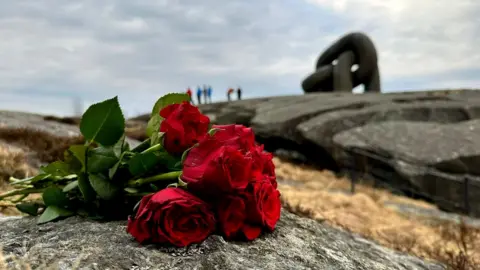 BBC
BBC
Follow BBC North East on Facebook, X (formerly Twitter), and Instagram. Send your story ideas to [email protected].
